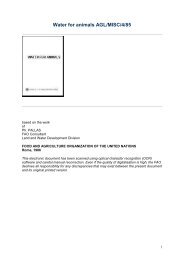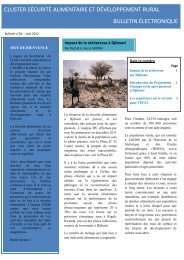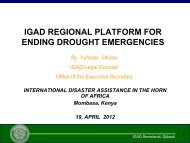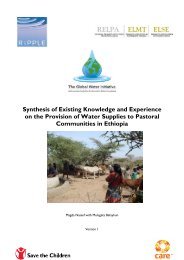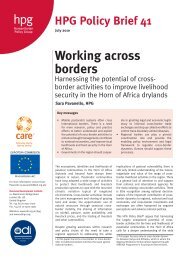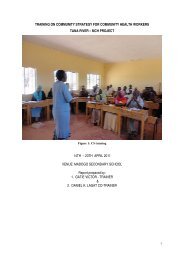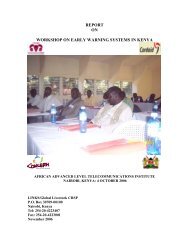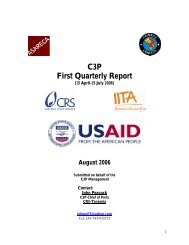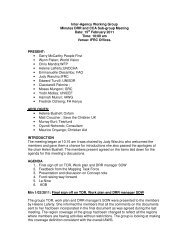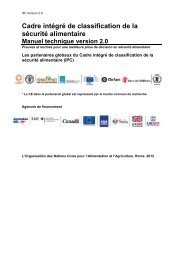A TrainerÕs Manual for Community Managed Water Supplies in Kenya
A TrainerÕs Manual for Community Managed Water Supplies in Kenya
A TrainerÕs Manual for Community Managed Water Supplies in Kenya
- No tags were found...
Create successful ePaper yourself
Turn your PDF publications into a flip-book with our unique Google optimized e-Paper software.
IntroductionINTRODUCTION1. Background<strong>Community</strong> managed water supply systems play a significant role <strong>in</strong> provid<strong>in</strong>g water services to the<strong>Kenya</strong>n public. However many community managed water supplies cont<strong>in</strong>ue to under-per<strong>for</strong>m andrequire support <strong>in</strong> terms of <strong>in</strong>frastructure improvement, strengthen<strong>in</strong>g of management and f<strong>in</strong>ancialsystems, operation and ma<strong>in</strong>tenance, and better <strong>in</strong>clusion <strong>in</strong>to the regulatory framework. It isrecognized that many organizations, <strong>in</strong>clud<strong>in</strong>g the M<strong>in</strong>istry of <strong>Water</strong> and Irrigation, have and cont<strong>in</strong>ueto respond to the need to improve the water services offered by the community managed supplies.This Tra<strong>in</strong>er’s <strong>Manual</strong> aims to support the process of build<strong>in</strong>g susta<strong>in</strong>able community managed watersupplies.2. Development of the <strong>Manual</strong>A variety of water supply tra<strong>in</strong><strong>in</strong>g manuals already exist, deal<strong>in</strong>g with different topics and provid<strong>in</strong>gdifferent levels of detail relevant to community managed water supplies. So why another manual?This Tra<strong>in</strong>er’s <strong>Manual</strong> was commissioned by FAO and UNICEF, on behalf of the <strong>Water</strong>/NRMTechnical Work<strong>in</strong>g Group, to respond to a stated need <strong>for</strong> a comprehensive manual cover<strong>in</strong>gf<strong>in</strong>ancial, organisational, legal and technical aspects of community based water supply managementwhich could be used by any state or non-state organisation to support capacity build<strong>in</strong>g activities. Inaddition, the <strong>Manual</strong> was <strong>in</strong>tended to <strong>in</strong>corporate specific issues (e.g. per<strong>for</strong>mance monitor<strong>in</strong>g,compliance to regulations and sector guidel<strong>in</strong>es, rights based approaches, etc) that have beenemphasised under the water sector re<strong>for</strong>ms <strong>in</strong> <strong>Kenya</strong>.3. Scope of the <strong>Manual</strong>There is enormous diversity with<strong>in</strong> the community managed water supplies <strong>in</strong> <strong>Kenya</strong> <strong>in</strong> terms ofwater source, <strong>in</strong>frastructure, scale and cultural context. As a result, the content of the <strong>Manual</strong> covers adiverse range of topics. Consequently there is a responsibility on the tra<strong>in</strong>er to make sure that thecontent and level of detail is adapted and made appropriate to each particular community tra<strong>in</strong><strong>in</strong>goccasion.The <strong>Manual</strong> is focused on community managed water supplies. In the past there has been tremendousef<strong>for</strong>t to <strong>in</strong>corporate sanitation and hygiene elements with<strong>in</strong> community water projects. Afterconsultations with stakeholders it was felt that there is adequate documentation on hygiene andsanitation tra<strong>in</strong><strong>in</strong>g and there<strong>for</strong>e facilitators are referred to recognised materials onCHAST/PHAST/CLTS tra<strong>in</strong><strong>in</strong>g to cover these topics.The <strong>Manual</strong> is not <strong>in</strong>tended to be used as a reference <strong>for</strong> the design of water supplies. The <strong>Manual</strong>focuses on build<strong>in</strong>g understand<strong>in</strong>g, knowledge and skills with<strong>in</strong> the community members and theirmanagement structures on a range of organisational, legal, f<strong>in</strong>ancial, and technical issues relevant tooperat<strong>in</strong>g the water supply <strong>in</strong>frastructure efficiently and effectively <strong>in</strong> order to provide an improvedand susta<strong>in</strong>able water supply.4. Purpose of this Tra<strong>in</strong>er’s <strong>Manual</strong>This <strong>Manual</strong> is <strong>in</strong>tended as a resource <strong>for</strong> tra<strong>in</strong>ers or facilitators as they prepare the tra<strong>in</strong><strong>in</strong>g materials<strong>for</strong> <strong>in</strong>dividual tra<strong>in</strong><strong>in</strong>g activities.The <strong>Manual</strong> is not <strong>in</strong>tended as a document that is left with the community, nor does it conta<strong>in</strong> manyhandouts <strong>for</strong> the community. The approach adopted has been to provide the facilitator with relevantand appropriate materials. It is expected that dur<strong>in</strong>g the tra<strong>in</strong><strong>in</strong>g and capacity build<strong>in</strong>g process thecommunity will establish their own procedures, operation and ma<strong>in</strong>tenance schedules, <strong>for</strong>ms and1



